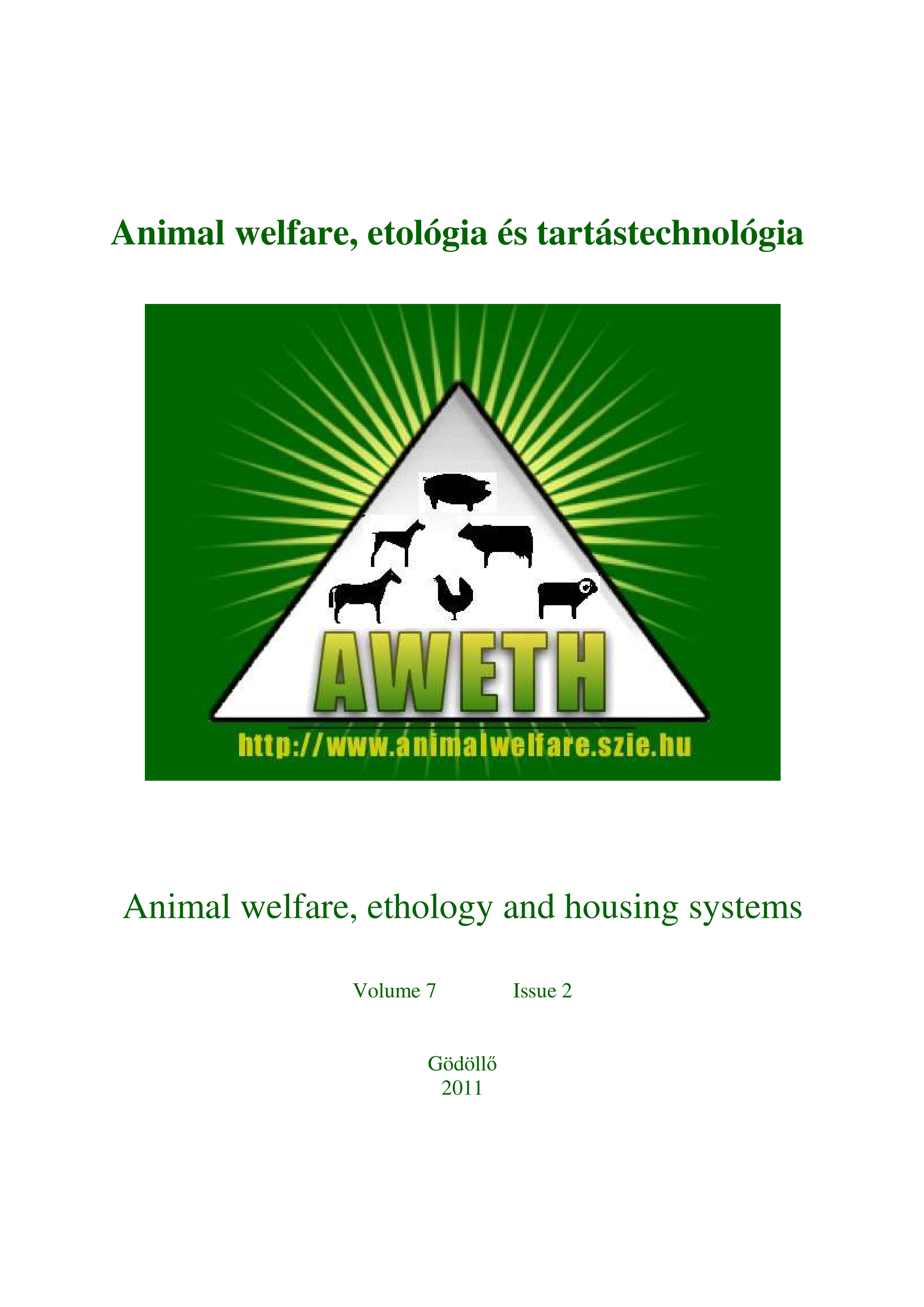Effect of stable climate on milk content and technological properties of bulk tank samples in Czech Pied Cattle
Keywords:
cows, milk production, stable temperature, relative humidity, heat stressAbstract
The aim of this research was to investigate the effect of stable climate on milk content and technological properties of bulk tank milk samples. It was analysed 29 weeks’ samples on private farm in Říčany (3.6. – 16. 12. 2010). Milk originates from approx. 720 Czech Pied Cattle cows with average 7.500 kg/lactation. One day before taking samples average daily temperature and relative humidity were recorded. The bulk tank samples were analysed for average values of fat content (%), protein content (%), lactose (%), SNF – solids non fat (%), TA - titratable acidity (Soxhlet Henkel), RCT - rennet coagulation time (s) and quality of curd (class 1–5).
It was found that the minimal and maximal daily temperature resp. relative humidity changed in range -7.4–26.2 °C resp. 53.7–98.9 %. It means that in particular periods dairy cows were exposed to heat stress. In mentioned periods (when temperature was close to 26 °C) lower protein and fat content of milk was found and worse curd quality was frequently experienced although RCT was longer in colder period. Close correlation was confirmed between stable temperature and protein, fat resp. SNF content (r = -0.88, -0,85 resp. -0.84; P < 0.01). Correlation coefficients of stable relative humidity with other parameters were contrary to those of stable temperature. Correlation between stable temperature and relative humidity was r = -0.66 (P < 0.01). Other parameters were not affected by stable temperature or humidity.
References
A.M.S. (1989): Glossary of Meteorology, 5th ed. American Meteorological Society, Boston, MA.
Beatty, D. T., Barnes, A., Taylor, E., Pethick, D., McCarthy, M., Maloney, S. K. (2006): Physiological responses of Bos taurus and Bos indicus cattle to prolonged, continuous heat and humidity. J. Anim. Sci., 84(4) 972–985. https://doi.org/10.2527/2006.844972x
Berman, A., Folman, Y., Kaim, M., Mamen, M., Herz, Z., Wolfenson, D., Arieli, A., Graber, Y. (1985): Upper critical temperatures and forced ventilation effects for high-yielding dairy cows in a subtropical climate. J. Dairy Sci., 68(6) 1488–1495. https://doi.org/10.3168/jds.S0022-0302(85)80987-5
Bernabucci, U., Lacetera, N., Ronchi, B., Nardone A. (2002): Hot season and milk protein fractions in Holstein cows. Anim. Res., 51(1) 25–33. https://doi.org/10.1051/animres:2002006
Brouček, J., Mihina, Š., Ryba, Š., Tongeľ, P., Kišac, P., Uhrinčať, M., Hanus, A. (2006): Effects of high air temperatures on milk efficiency in dairy cows. Czech J. Anim. Sci., 51(3): 93–101. https://doi.org/10.17221/3915-CJAS
Brown-Brandl, T. M., Eigenberg, R. A., Nienaber, J. A. (2006): Heat stress risk factors of feedlot heifers. Livestock Science, 105(1–3) 57–68. https://doi.org/10.1016/j.livsci.2006.04.025
Davis, M. S., Mader, T. L., Holt, S. M., Parkhurst, A. M. (2003): Strategies to reduce feedlot cattle heat stress: Effects on tympanic temperature. J. Anim. Sci., 81(3) 649–661. https://doi.org/10.2527/2003.813649x
Falta, D., Walterová, L., Skýpala, M., Chládek, G. (2008): Effect of stable microclimate on milk production of Holstein cows on 2nd and 3rd lactation. [online], Animal welfare, etológia és tartástechnológia. 4(2) 104–110.
Gajdůšek, S. (1999): Milk processing II –practise. Mendel University in Brno, (in czech), p. 92.
Hahn, G. L. (1999): Dynamic responses of cattle to thermal heat loads. J. Anim. Sci., 77(Suppl. 2) 10–20. https://doi.org/10.2527/1997.77suppl_210x
Hanuš, O., Vyletělová, M., Genčurová, V., Jedelská, R., Kopecký, J. Nezval, O. (2008): Hot stress of Holstein dairy cows as substantiv factor of milk composition. Scientia Agriculturae Bohemica, 39(4): 310–317.
Chládek, G., Čejna, V. (2005): Measuring of rennet coagulation time by Nephelo-turbidimetric sensor of milk coagulation. Mléko a sýry 2005, (in czech), Prague, p. 127–130.
Ikonen, T., Morri, S., Tyrisevä, A. M., Routtinen, O., Ojala, M. (2004): Genetic and phenotypic correlations between milk coagulation properties, milk production traits, somatic cell count, casein content and pH of milk. J. Dairy Sci., 87(2) 458–467. https://doi.org/10.3168/jds.S0022-0302(04)73185-9
Kadzere, C. T., Murphy, M. R., Silanikove, N., Maltz, E. (2001): Heat stress in lactating dairy cos: a review. Livestock Production Science, 77(1) 59–91. https://doi.org/10.1016/S0301-6226(01)00330-X
Mader, T. L., Davis, M. S. (2004): Effect of management strategies on reducing heat stress of feedlot cattle: Feed water intake. J. Anim. Sci., 82(10) 3077–3087. https://doi.org/10.2527/2004.82103077x
Mitlöhner, F. M., Galyean, M. L.,McGlone, J. J. (2002): Shade effects on performance, carcass traits, physiology, and behavior of heat-stressed feedlot heifers. J. Anim. Sci., 80(8) 2043–2050. https://doi.org/10.1093/ansci/80.8.2043
Ozrenk, E., Inci, S. S. (2008): The effect of seasonal variation on the composition of cow milk in Van Province. Pakistan Journal of Nutrition, 7(1) 161–164. https://doi.org/10.3923/pjn.2008.161.164
Sevi, A., Annicchiarico, G., Albenzio, M., Taibi, L., Muscio, A., Dell´Aquila, S. (2001): Effects of solar radiation and feeding time on behavior, immune responses and production of lactating ewes under high ambient temperature. J. Dairy Sci., 84(3) 629–640. https://doi.org/10.3168/jds.S0022-0302(01)74518-3
Vokřálová, J., Novák, P. (2005): Climatic extrems and lactation. (in Czech), Náš chov, 9: 40–42.
West, J. W. (2003): Effects of Heat-Stress on Production in Dairy Cattle. J. Dairy Sci., 86(6) 2131–2144. https://doi.org/10.3168/jds.S0022-0302(03)73803-X
Downloads
Published
Issue
Section
License
Copyright (c) 2011 Daniel Falta, Ondřej Polák, Gustav Chládek

This work is licensed under a Creative Commons Attribution-NonCommercial-NoDerivatives 4.0 International License.
The journal operates according to the principles of open access, however, the content is available under the Creative Commons 4.0 standard licenc: CC-BY-NC-ND-4.0. Under the following terms: You must give appropriate credit, provide a link to the license, and indicate if changes were made. You may do so in any reasonable manner, but not in any way that suggests the licensor endorses you or your use. You may not use the material for commercial purposes. If you remix, transform, or build upon the material, you may not distribute the modified material. You may not apply legal terms or technological measures that legally restrict others from doing anything the license permits.














